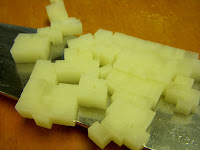Day 2, Tuesday
9.30.2008
My supplies are out and ready for action: French Knife, Paring Knife, Knife Steele, Vegetable Peeler, Scale, and Sharpening Block/Stone.
Set up is my knife station, my tools on a sheet tray with parchment, and a sanitation bucket is underneath the counter. I am ready up to sharpen my French knife on my sharpening stone. It is a double-sided grinding stone with one side rougher than the other that works best when used with mineral oil or water. Since I have never done this before, I was paying very close attention to Chef Mangalore as he was demonstrating the proper way to go about this.
I moistened my knife and the stone with some water, and holding the knife at a 20 degree angle, I applied slight pressure to the knife as I pulled it evenly across the surface of the stone. Always move with the knife blade away from your body, never pulling it towards you. I counted 10 swipes on each side. Count to make sure you are doing the same amount on both sides, uneven sharpening will cause the blade to loose its v-shaped edge and therefore dull the knife. Next I move on to honing my knife, which Chef says should be done before each use. Sharpening does not need to be done each time. This fine tuning tool follows the same as the previous, a 20 degree angle with even passes on each side.
Today's instruction on cutting carrots includes:
-Dicing and Julienne
My peeled carrots, measuring tape and french knife, scale, and waste bowl
Sizes of dices and slices:
Large Dice- 2cm x 2 cm x 2 cm
Medium Dice- ½ inch cube
Small Dice- ¼ inch cube
Brunoise (Fine Dice)- 1/8 inch cube
Paysanne- ½" x ½" x 1/8"
Julienne- 1/8" x 1/8" x 2 1/2"
Bâtonnet- ¼" x 1/4" x 2 1/2"
Before I begin I make sure I have a good grip on my knife and that it is comfortable in my hand. With my other hand I keep my fingers flat and serve as a guide for my knife while I hold the carrot in place.
The smaller dices were easier to make. I began by cutting 2 1/2" long pieces that were 3/4" wide and tall and then made 1/8" slices. Those then became my Julienne slices at 1/8" x 1/8" x 2 1/2". To make the Brunoise fine dices I cut the Juliennes again to make the 1/8" cubes. The 2 1/2" long pieces I also sliced into flat "squares", the Paysanne, at 1/2" x 1/2" x 1/8".
Part Two: Potatoes
I peeled my 2.14 lb of potatoes and had a scaled waste of 5 1/8 oz, not too bad I thought. But by the end, let's say I was ready to be done dicing potatoes.


What I thought was one of my nearly perfect large dices








You do make a beautiful cubed potato but my question is this - who eats cubed potatoes? I've never seen one in real life.
ReplyDelete